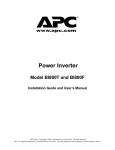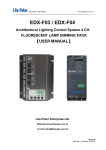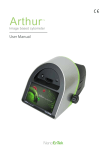Download American Power Conversion HI600SQ User's Manual
Transcript
® w w w.apc.com Home Appliance & Lighting UPS HI600SQ Installation Guide and User’s Manual 990-2884 Copyright © 2005 American Power Conversion. All rights reserved. APC is a registered trademark of American Power Conversion. All other trademarks are the property of their respective owners. CONTENTS Page Overview Checklist Section 1. Unpacking/Inspection of Home UPS (at reseller location) 1 1 1 Section 2. Unpacking/Inspection of Home UPS (at customer location) 1 Section 3. Installation Home UPS Placement Location Selection Battery Connection Install Home UPS 2 2 2 2 Section 4. Controls and Indicators Home UPS Controls AWAY/HOME TEST/MUTE Circuit Breaker Switch Home UPS Indicators Cold Boot Section 5. Troubleshooting Manual Bypass 3 3 3 3 3 3 Preventive Maintenance 6 Specifications 7 Warranty 7 Contact Information 7 5 5 FIGURES Figure 1. Figure 2. Figure 3. Figure 4. Figure 5. APC Home UPS Typical Home Wiring After Home UPS Installation Home UPS Connections Home UPS Front Panel Controls and Indicators Home UPS Bypass Connection 1 2 3 4 6 TABLES Table 1. Table 2. Table 3. Table 4. Home UPS Indicators Load Indications Home UPS Troubleshooting APC Home Appliance & Lighting UPS Technical Specifications i 4 4 5 7 Thank you for purchasing APC’s Home Appliance & Lighting UPS. Please fill out the enclosed Warranty Registration Card, or register your purchase on-line at: www.apc.com/support. Overview APC’s Home UPS (Figure 1) is designed for years of trouble-free use. The Home UPS is a squarewave back-up power supply intended to serve house loads. It is rated for 600 VA/360W at 230 Vac, 50-Hz, and operates on a wide range of input voltages (100 - 270V). If the input voltage goes out of range (less than 100V or more than 270V), the utility is isolated and the UPS supplies power to the load from an externally connected battery (may be purchased from APC, or from the supplier of your choice). The UPS can serve inductive loads (fluorescent lamps, ceiling and table fans), resistive loads (incandescent lamps), and switched mode power supply (SMPS) loads (television). Figure 1. APC Home UPS Checklist: Depending on what the customer has ordered, ensure the following items have been delivered: • • Home UPS Wiring Kit Section 1. Unpacking/Inspection of Home UPS (at reseller location) ! Warning: The Home UPS weighs 7 kg. Please handle carefully. Inspect the shipping containers for signs of obvious damage. If damage to either shipping container is extensive, notify the carrier and return the unit to the factory. If there are no apparent signs of damage, carefully open the container, and remove the packing materials (do not discard). Inspect for dents, scratches, warpage of the top cover, or other signs of damage. If unit is damaged, please notify the factory and obtain a Return Material Authorization number and return the unit as/if instructed. If there are no obvious signs of damage, repackage the unit for shipment to the customer using the materials already removed from the shipping container. Ship or otherwise deliver the unit to the customer location. Section 2. Unpacking/Inspection of Home UPS (at customer location) Note: The Home UPS Assembly is shipped with two (one male and one female) IEC connectors and battery assembly wiring for use in installing home wiring to/from the Home UPS. Inspect the shipping containers for signs of obvious damage. If damage to either shipping container is extensive, notify the carrier and return the unit to the factory. If there are no apparent signs of damage to the shipping container, carefully open the container, and remove the packing materials (do not discard). ! Warning: The Home UPS weighs 7 kg. Please handle carefully. Remove the item from the shipping container and Inspect for: dents, scratches, warpage of the top cover, or other signs of damage. If unit is damaged, please notify the factory and obtain a Return Material Authorization number and return the unit as/if instructed. Page 1 Section 3. Installation Home UPS Placement Note: Once the unit has been completely installed, it is not desirable to move it. Location selection - Ensure the area where the unit is to be placed is not in direct sunlight (surfaces may become hot). Further ensure the unit is placed in a dry area away from sources of liquids, and that the vents on each side have at least 15 cm (6 inches) of unobstructed clearance. Battery Connection Connect the red battery terminal lead (protrudes from the lid) to the positive (+) terminal of the battery and connect the black battery terminal lead (protrudes from the lid) to the negative (-) terminal. Install Home UPS Caution: Installation of the Home UPS must be performed by a licensed and qualified electrician. Failure to comply may result in equipment damage, and may also void the Warranty. Figure 2 shows a typical home wiring scenario after installation of the Home UPS Assembly wiring. Note: The Home UPS can serve inductive loads (fluo rescent lamps, ceiling and table fans), resistive loads (incandescent lamps), and SMPS loads (television). Caution: Connecting the Home UPS to a branch circuit that exceeds 16 amps may result in equipment damage. Note: Home wiring to power the desired loads should be routed and connected to a single branch circuit providing a maximum of 16 amps to the circuit, Wiring must be in accordance with local electric codes and standards. Connected loads must not exceed 360 watts when the Home UPS is On Battery. Electricity Board Meter E E N N L L Load Double-Pole Switch Lighting Circuit Input Output Wiring for Home UPS Figure 2. Typical Home Wiring After Home UPS Installation Connect one end of the electrical cable from the double-pole switch lighting circuit in accordance with local electric codes and standards. Connect the other end of the electrical cable to the provided IEC connector, and then to the rear panel Input connector on the Home UPS Assembly (Figures 2 and 3). Connect one end of the electrical cable from the load in accordance with local electric codes and standards. Connect the other end of the electrical cable to the provided IEC connector, and then to the rear panel Output connector on the Home UPS Assembly (Figures 2 and 3). Connect the battery wiring harness from the battery to the rear panel input connector of the Home UPS (Figure 3) marked 12V Battery. Once the home wiring is complete and the batteries are connected to the Home UPS Assembly, turn on power at the Electricity Board Meter then at the Double-Pole Switch Lighting Circuit. The Home UPS will automatically turn on. Page 2 12V Battery INPUT +Ve Push to Reset -Ve N L L OUTPUT N Input : 230V, 5A, 50Hz Output : 230V, 5A, 50HZ Battery Wiring Output Harness (Red and Black Wires) These connectors are provided with the Home UPS Assembly and must be installed on to the wiring. From Electricity Board Meter (through Double-Pole Switch Lighting Circuit) To Load Figure 3. Home UPS Connections Section 4. Controls and Indicators Please review this section thoroughly before applying power to the Home UPS. Home UPS Controls - Controls provided on the Home UPS consist of the holiday mode switch marked AWAY/HOME, and the Test/Mute switch, as well as a rear panel Push to Reset circuit breaker, and are defined in the following: AWAY/HOME - (also known as the holiday mode switch) - In the HOME position, this two-position rocker switch (Figure 4) sets the Home UPS so that it will switch to battery output when there is a utility power outage. In the AWAY position, the Home UPS goes into standby mode and will not switch to battery power in the event of a power outage. This is to conserve the batteries. However, in this position, the Home UPS will charge the batteries until a utility power failure occurs. TEST/MUTE - In TEST mode, when ON MAINS LED is lit, on pressing this push button, the unit will do self test to determine the state of the system. During On Battery self test it will also show the load status which can be used to find out the load capacity. In the MUTE position (push in for 5 seconds), this push button switch silences the low battery buzzer. Circuit Breaker Switch (Rear Panel) - When in ON MAINS mode, if the system draws more than 10A, circuit breaker will trip. To reset the circuit breaker switch, push the switch fully inward. Home UPS Indicators - The Home UPS provides light emitting diode (LED) indicators (Figure 4) to show the operational condition of the Home UPS and batteries. Indicators consist of Inverter Load Status (25%, 50%, 75%, 100%, and OVER LOAD). Other indicators consist of: INVERTER DISABLE, ON MAINS, ON BATTERY, and FAULT). Using Table 1, determine the condition of the Home UPS and battery. Cold Boot - To turn on the Home UPS on Battery Mode, press the Test-Mute button and hold it for 2-3 seconds. Page 3 AWAY 25% 50% 75% 100% TEST OVER LOAD INVERTER LOAD ON INVERTER ON DISABLE MAINS BATTERY FAULT MUTE HOME Figure 4. Home UPS Front Panel Controls and Indicators Table 1. Home UPS Indicators On Mains (green) On Battery (yellow) Fault (red) INV Disable (red) Buzzer On Off Off Off Off The unit is ON-LINE. ON LINE SELF TEST Flashing Off Off Off Off The unit is in ON-LINE Self-Test mode. ON BATTERY SELF TEST Flashing On Off Off Off The unit is in ON-BATTERY Self-Test mode, and the load is less than 25%. ON BATTERY Off On Off Off BATTERY DISCONNECTED On Off Flashing Off Chirp every 2 seconds The unit is ON-LINE mode; battery is disconnected. Short Circuit (heavy overload) Off Off On Off Continuously On The unit is in FAULT state, due to short circuit fault. ON BATTERY Low Battery Warning Off On Off Off Constant Beeping, Can be muted through front panel TEST/MUTE push button. Mode ON LINE Description The unit is in ON-BATTERY mode, and the load is less than 25%. Table 2. Load Indications 25% 50% 75% 100% Overload Buzzer Description Power Meter on off off off off off The unit is in ON-BATTERY mode, and the load is less than 25%. Power Meter on on off off off off The unit is in ON-BATTERY mode, and the load is between 25% and 50%. Power Meter on on on off off off The unit is in ON-BATTERY mode, and the load is between 50% and 75%. Power Meter on on on on off off The unit is in ON BATTERY mode; the load is between 75% and the overload limit. NOTE: In the case of a sustained overload, the Home UPS will be turned off automatically after one minute, and will wait in the fault state for a minute. After that, it will restart again. If the overload still persists, the Home UPS will be turned off again after one minute, and will wait in fault state for one minute and restart again. In the same way, it will try for three restarts. If the overload still persists, it will stay in fault state permanently until the unit is restarted with push button. If the time interval between two consecutive overloads is more than 5 minutes, then the latest overload is considered as a fresh overload and three restart cycle will begin again. Page 4 Section 5. Troubleshooting Note: If the Home UPS causes interference with a television while ON-BATTERY, move the television at least 3 feet away from the Home UPS. Use the information provided in Tables 1, 2, and 3 to diagnose Home UPS problems. If the problem cannot be resolved using the information provided in this manual, contact APC Technical Support. Table 3. Home UPS Troubleshooting Problem Home UPS fails to operate when mains power is turned on, or during a utility power failure. Home UPS faults. Cause Corrective Action Disconnected battery. Ensure batteries are connected as defined in this manual. Power is off at the Mains. Turn on power at the Mains. Home UPS HOME/AWAY switch in the AWAY position. Set switch to the HOME position. Dead batteries. Home UPS failed to charge batteries, or batteries were allowed to completely discharge. Replace batteries. If replacing the batteries does not fix the problem, contact APC Technical Support. Home UPS rear panel Push to Reset circuit breaker has tripped. Reset the circuit breaker by pushing it fully inward until it stops; release the circuit breaker. Improper wiring installation or loose connection. Ensure wiring is as described earlier in this manual, and that all connections are secure. Home UPS drops the load. Home UPS may have an internal failure. If this happens, the unit can be disconnected from the mains by completion of a Manual Bypass (see Manual Bypass). Home UPS is overloaded. Turn off some loads connected to the Home UPS until the OVER LOAD LED is no longer lit Manual Bypass - In the event of Home UPS failure or dead battery condition, the Home UPS can be disconnected from the mains and power restored to the circuit by completing a Manual Bypass (Figure 6) of the Home UPS, as follows: Remove the Wiring Management Kit from the Home UPS. Disconnect all wires connected at the Home UPS rear panel. Connect the wire from the Input socket to the wire from the Output socket. Page 5 INPUT N L L OUTPUT N Push to Reset Input : 230V, 5A, 50Hz Output : 230V, 5A, 50HZ Disconnect from Home UPS Connect Both Wires Completed Bypass Connection Figure 5. Home UPS Bypass Connection Preventive Maintenance - Preventive maintenance consists of inspecting the batteries for cracks and/or leakage, and checking battery fluid levels and filling the batteries every 90 days. Page 6 Specifications Table 4. APC Home Appliance & Lighting UPS Technical Specifications Item Specification Nominal Voltage 230 V Rated Voltage 230 V Frequency 47-53 Hz Nominal Rated Current 2.61 A Input Circuit Breaker Rating 10 A Input Voltage Window for Utility Operation 100 - 270 VAC Voltage (on Mains) 100 - 270 VAC Voltage (on battery) 180 - 250 VAC Rated VA 600 VA Rated Watts 360 W Overload Indicated ON BATTERY >100% Shutdown due to OVERLOAD > 100% after 60 seconds (see Table 1 and following note) Frequency (ON BATTERY) 50 Hz +/- 1% Surge Protection Built-in Surge Protection Protects the load from surges and spikes Environmental Ambient Operating Temperature 0-45 degrees C Humidity 95% Relative humidity, non-condensing Altitude 3000 m Input Line IEC socket Outlet Receptacles IEC socket Dimensions - Unit (h) x (w) x (d) UPS: 13.0 x 50.6 x 29.3 cm Weight UPS : 7 kg Shipping Weight UPS : 8 kg Input Characteristics Output Characteristics Physical Warranty APC Warrants its products to be free from defects in materials and workmanship under normal use and service for 2 years for the Home UPS, and 2 years for the Batteries to the original purchaser. Its obligation under this warranty is limited to repairing or replacing, at its sole option, any such defective products. To obtain service under warranty you must obtain a Return Material Authorization (RMA) number from APC Technical Support or an APC Service Center. The defective unit must be returned with an RMA number, with transportation charges prepaid and it must be accompanied by a brief description of the problem and proof of date and place of purchase. This warranty applies only to the original purchaser. Contact Information APC Corporate Office 132 Fairgrounds Road West Kingston, RI 02892, USA Tel: 401-789-0204 APC Corporate Office (India) 27 Lavelle Road, Bangalore 560 001 www.apc.com Toll Free Helpline: 1600 444 272 and 1600 444 877 email: [email protected] Technical Webchat: www.apc.com/in Page 7


















